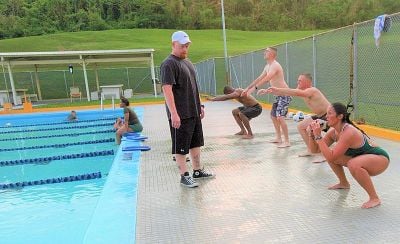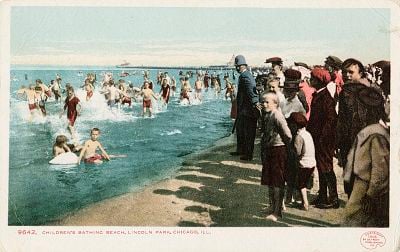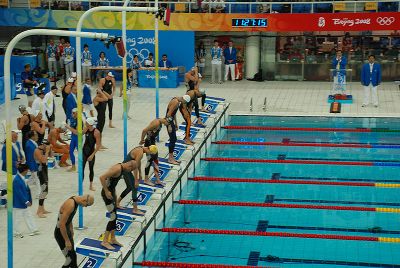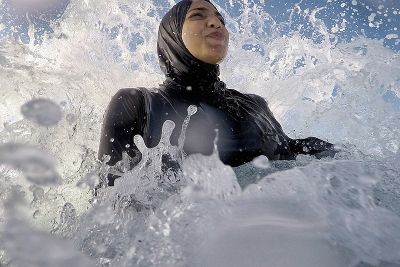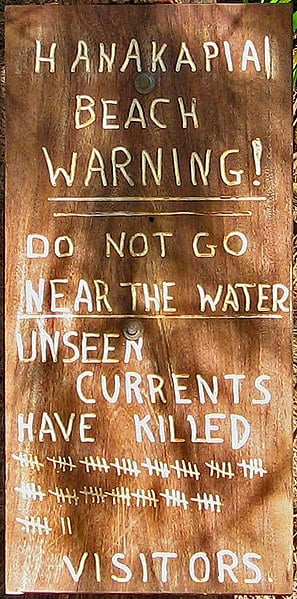Swimming
Swimming is self-propulsion through water, or other liquid, usually for recreation, sport, exercise, or survival. Locomotion is achieved through coordinated movement of the limbs and the body to achieve hydrodynamic thrust that results in directional motion. This article focuses on human swimming, although many non-aquatic animals are also able to swim.
Swimming is consistently among the top public recreational activities. As a formalized sport, swimming is featured in a range of local, national, and international competitions, including every modern Summer Olympics.
Swimmers often wear specialized swimwear, although depending on the culture of the area, some swimmers may also swim nude or wear their day attire. In addition to this, a variety of equipment can be used to enhance the swimming experience or performance, including but not limited to the use of swimming goggles, flotation devices, swim fins, and snorkels.
There are various risks present during swimming, mainly due to it taking place in water. Swimmers are at risk of incapacitation due to panic and exhaustion, which may cause death due to drowning. Other dangers include getting an infection or contact with hostile aquatic fauna. To minimize these risks, most facilities employ a lifeguard to look for signs of distress. With safety features in place, swimming is a healthy activity that can be enjoyed by all ages.
History
Swimming has been recorded since prehistoric times, and the earliest records of swimming date back to Stone Age, as much as 10,000 years ago. For example, the Cave of Swimmers, a cave with ancient rock art in the mountainous Gilf Kebir plateau of the Libyan Desert section of the Sahara, contains depictions of people with their limbs bent as if they were swimming.
Written references date from 2,000 B.C.E. Some of the earliest references include the Epic of Gilgamesh, the Iliad, the Odyssey, the Bible (Ezekiel 47:5, Acts 27:42, Isaiah 25:11), Beowulf, and other sagas.
The coastal tribes living in the Low Countries were known as excellent swimmers by the Romans. Men and horses of the Batavi tribe could cross the Rhine without losing formation, according to Tacitus. Dio Cassius describes one surprise tactic employed by Aulus Plautius against the Celts at the Battle of the Medway:

The [British Celts] thought that Romans would not be able to cross it without a bridge, and consequently bivouacked in rather careless fashion on the opposite bank; but he sent across a detachment of [Batavii], who were accustomed to swim easily in full armour across the most turbulent streams. ... Thence the Britons retired to the river Thames at a point near where it empties into the ocean and at flood-tide forms a lake. This they easily crossed because they knew where the firm ground and the easy passages in this region were to be found, but the Romans in attempting to follow them were not so successful. However, the [Batavii] swam across again and some others got over by a bridge a little way up-stream, after which they assailed the barbarians from several sides at once and cut down many of them.[1]
Science
Swimming relies on the nearly neutral buoyancy of the human body. On average, the body has a relative density of 0.98 compared to water, which causes the body to float. However, buoyancy varies on the basis of body composition, lung inflation, muscle and fat content, center of gravity, and the salinity of the water. Higher levels of body fat and saltier water both lower the relative density of the body and increase its buoyancy.
Since the human body is less dense than water, water is able to support the weight of the body during swimming. As a result, swimming is “low-impact” compared to land activities such as running. The density and viscosity of water also create resistance for objects moving through the water. Swimming strokes use this resistance to create propulsion, but this same resistance also generates drag on the body.
Hydrodynamics is important to stroke technique for swimming faster, and swimmers who want to swim faster or exhaust less try to reduce the drag of the body's motion through the water. To be more hydrodynamically effective, swimmers can either increase the power of their strokes or reduce water resistance, though power must increase by a factor of three to achieve the same effect as reducing resistance. Efficient swimming can be achieved by reducing water resistance involves a horizontal water position, rolling the body to reduce the breadth of the body in the water, and extending the arms as far as possible to reduce wave resistance.[2]
Just before plunging into the pool, swimmers may perform exercises. For example, squatting helps in enhancing a swimmer's start by warming up the thigh muscles.[3]
Purpose
There are many reasons why people swim, from swimming as a recreational pursuit to swimming as a necessary part of a job or other activity. Swimming may also be used to rehabilitate injuries, especially various cardiovascular and muscle injuries. People may also pursue swimming as a career or field of interest. Some may be gifted and choose to compete professionally.
Swimming over brief distances is frequent when alternatives are precluded. There have been cases of political refugees swimming in the Baltic Sea and of people jumping in the water and swimming ashore from vessels not intended to reach land where they planned to go.[4]
Recreation
Many swimmers swim for recreation, with swimming consistently ranking among the top public recreational activities.[5]
Recreational swimming can also be used for exercise, relaxation, or rehabilitation.[6] The support of the water, and the reduction in impact, makes swimming accessible for people who are unable to undertake activities such as running. Swimming is one of the most relaxing activities, water is known to calm us and can help reduce stress.
Health
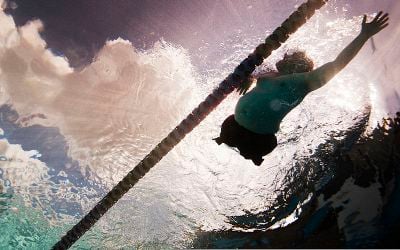
Regular swimming activities contribute to the restoration of health, and in many cases, complete recovery.
Swimming is primarily a cardiovascular/aerobic exercise due to the long exercise time, requiring a constant oxygen supply to the muscles, except for short sprints where the muscles work anaerobically.[7] Furthermore, swimming can help tone and strengthen muscles.[8] Swimming allows sufferers of arthritis to exercise affected joints without worsening their symptoms. As with most aerobic exercise, swimming reduces the harmful effects of stress. Swimming is also effective in improving health for people with cardiovascular problems and chronic illnesses. Swimming is an ideal workout for the elderly, as it is a low-impact sport with very little risk of injury. Exercise in the water works out all muscle groups, helping with conditions such as muscular dystrophy which is common in seniors. Swimming can even improve mood, and has been shwon to positively impact the mental health of pregnant women and mothers. [9]
Sport
Swimming as a sport predominantly involves participants competing to be the fastest over a given distance in a certain period of time. Competitors swim different distances in different levels of competition. For example, swimming has been an Olympic sport since 1896, and the current program includes events from 50 m to 1500 m in length, across all four main strokes as well as medley. During the season competitive swimmers typically train several times a week in order to preserve fitness.
The sport is governed internationally by World Aquatics, formerly known aas the International Swimming Federation/Fédération Internationale de Natation (FINA). Competition pools for international events are 25 or 50 meters in length. The standard pool is 25 meters long and has 6-10 lanes. The Olympic size pool is 50 meters with 8 to 10 lanes. In the United States, a pool 25 yards in length is commonly used for competition.[10]
Other swimming and water-related sporting disciplines include open water swimming, diving, synchronized swimming, water polo, triathlon, and the modern pentathlon.
Safety
As a popular leisure activity done all over the world, one of the primary risks of swimming is drowning. Drowning may occur from a variety of factors, from swimming fatigue to simply inexperience in the water.
To minimize the risk and prevent potential drownings from occurring, lifeguards are often employed to supervise swimming locations such as pools, waterparks, lakes, and beaches. Lifeguards are certified after receiving appropriate training.[11]
In some countries, swimming lessons are a compulsory part of the educational curriculum.[12]
Human babies demonstrate an innate swimming or diving reflex from newborn until the age of approximately 6 months. The diving response involves apnea, reflex bradycardia, and peripheral vasoconstriction; in other words, babies immersed in water spontaneously hold their breath, slow their heart rate, and reduce blood circulation to the extremities (fingers and toes).[13]
Because infants are innately able to swim, classes for babies of about 6 months old are offered in many locations. This helps build muscle memory and makes strong swimmers from a young age.
Occupation
Some occupations require workers to swim, such as abalone and pearl diving, and spearfishing.
Swimming is also used in marine biology to observe plants and animals in their natural habitat. Other sciences use swimming; for example, Konrad Lorenz swam with geese as part of his studies of animal behavior.
Swimming also has military purposes. Military swimming is usually done by special operation forces, such as Navy SEALs and US Army Special Forces. Swimming is used to approach a location, gather intelligence, engage in sabotage or combat, and subsequently depart. This may also include airborne insertion into water or exiting a submarine while it is submerged. Due to regular exposure to large bodies of water, all recruits in the United States Navy, Marine Corps, and Coast Guard are required to complete basic swimming or water survival training.
Techniques
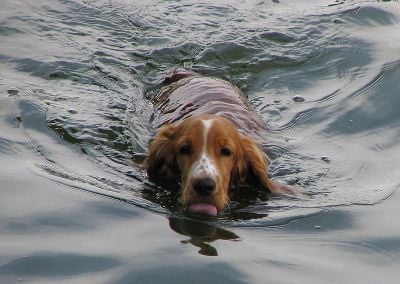
Swimming can be undertaken using a wide range of styles, known as "strokes," and these strokes are used for different purposes, or to distinguish between classes in competitive swimming. However, it is not necessary to use a defined stroke for propulsion through the water, and untrained swimmers may use a 'doggy paddle' of arm and leg movements, similar to the way four-legged animals swim. There are four main strokes used in contemporary competitive and recreational swimming: the front crawl, also known as freestyle, breaststroke, backstroke, and butterfly.
Competitive swimming in Europe started around 1800, mostly using the breaststroke. Butterfly was developed in the 1930s, and was considered a variant of the breaststroke until accepted as a separate style in 1953.[14] Butterfly is considered the hardest stroke by many people, but it is the most effective for all-around toning and the building of muscles. It also burns the most calories and can be the second fastest stroke if practiced regularly.[15]
In non-competitive swimming, there are additional strokes such as the sidestroke. The sidestroke is so named because the swimmer lies on one's side with asymmetric arm and leg motion. This stroke is helpful as a lifesaving technique and is often used for long-distance swimming. The sidestroke toward the end of the nineteenth century, this pattern was changed by raising one arm above the water first, then the other, and then each in turn. It is still used in lifesaving and recreational swimming. The trudgen, a variation on the sidestroke, was introduced by John Arthur Trudgen to Western swimming competitions in 1873.[16]
Other strokes exist for particular reasons such as training, school lessons, and rescue, and it is often possible to change strokes to avoid using parts of the body, either to separate specific body parts, such as swimming with only arms or legs to exercise them harder, or for amputees or those affected by paralysis.
Clothing and equipment
Swimsuits
Standard everyday clothing is usually impractical for swimming and is unsafe under some circumstances. Most cultures today expect swimmers to wear swimsuits.
Men's swimsuits commonly resemble shorts, or briefs. Men's casual swimsuits (for example, boardshorts) are rarely skintight, unlike competitive swimwear. In most cases, boys and men swim with their upper body exposed, except in countries where custom or law prohibits it in a public setting, or for practical reasons such as sun protection.
Modern women's swimsuits are generally skintight. They may be two-piece bikinis with a top piece that covers the breasts, and a bottom piece covering the pelvis (but usually exposing the navel) and the buttocks (fully or only partially), or one-piece swimsuits covering the torso. Women's swimwear is often a fashion statement, and whether it is modest or not is a subject of debate by many groups, religious and secular.
Competitive swimwear is built so that the wearer can swim faster and more efficiently. Modern competitive swimwear is skintight and lightweight, designed for use in aquatic competitions, such as water polo, swim racing, diving, and rowing.
Wetsuits provide both thermal insulation and flotation. Many swimmers lack buoyancy in the legs and the wetsuit provides additional volume at a lower density and therefore improves buoyancy and trim while swimming. It provides insulation between the skin and water which reduces heat loss. The wetsuit is the usual choice for those who swim in cold water for long periods of time, as it reduces susceptibility to hypothermia.
Some people also choose to wear no clothing while swimming; this is known as "skinny dipping." In some European countries public pools have naturist sessions to allow clothes-free swimming and many countries have naturist beaches where one can swim naked. Today, skinny dipping can be a rebellious activity or merely a casual one.
Accessories
- Ear plugs can prevent water from getting in the ears.
- Noseclips can prevent water from getting in the nose. However, using noseclips in competitive swimming can cause a disadvantage, so many competitive swimmers choose not to use them. For this reason, nose clips are primarily used for synchronized swimming and recreational swimming.
- Goggles protect the eyes from chlorinated water, and improve underwater visibility. Tinted goggles protect the eyes from sunlight that reflects from the bottom of the pool.
- Swim caps keep the body streamlined and protect the hair from chlorinated water, though they are not entirely watertight.
- Kickboards are used to keep the upper body afloat while exercising the lower body.
- Pull buoys are used to keep the lower body afloat while exercising the upper body.
- Swimfins are used in training to elongate the kick and improve technique and speed. Fins also build upper calf muscles. Fins provide a significantly greater and more efficient conversion of muscle power to thrust than available from the feet, and allow the powerful leg muscles to be used effectively for propulsion through water. The value of fins as an active aid in the teaching, learning and practice of swimming has long been recognized. In the US, as early as 1947, they were used experimentally to build the confidence of reluctant beginners in swimming,[17] while a YMCA lifesaving and water safety manual from the early 1950s reminded swimming instructors how "flippers can be used to great advantage for treading water, surface diving, towing, underwater searching and supporting a tired swimmer."[18]
- Hand paddles are used to increase resistance during arm movements, with the goal of improving technique and power.
- Finger paddles have a similar effect to handle paddles however due to their smaller size create less resistance. They also help with improving a swimmers 'catch' in the water.
- Snorkels are used to help improve and maintain a good head position in the water. They may also be used by some during physical therapy.
- Pool noodles are used to keep the user afloat during the time in the water.
- Swimming Parachutes are used in competitive training, adding an element of resistance in the water helping athletes to increase power in the strokes central movements.
- Inflatable armbands are swimming aids designed to provide buoyancy for the swimmer which helps the wearer to float.
Risks

There are many risks associated with voluntary or involuntary human presence in water, which may result in death directly or through drowning asphyxiation. Swimming is both the goal of much voluntary presence and the prime means of regaining land in accidental situations.
Most recorded water deaths fall into these categories:
- Panic occurs when an inexperienced swimmer or a non-swimmer becomes mentally overwhelmed by the circumstances of their immersion, leading to sinking and drowning. Occasionally, panic kills through hyperventilation, even in shallow water.
- Exhaustion can make a person unable to sustain efforts to swim or tread water, often leading to death through drowning. An adult with fully developed and extended lungs has generally positive or at least neutral buoyancy, and can float with modest effort when calm and in still water. A small child has negative buoyancy and must make a sustained effort to avoid sinking rapidly.
- Hypothermia, in which a person loses critical core temperature, can lead to unconsciousness or heart failure.
- Dehydration from prolonged exposure to hypertonic salt water, or, less frequently, salt water aspiration syndrome where inhaled salt water creates foam in the lungs that restricts breathing, can cause loss of physical control or kill directly without actual drowning. Hypothermia and dehydration also kill directly, without causing drowning, even when the person wears a life vest.
- Blunt trauma in a fast moving flood or river water can kill a swimmer outright, or lead to their drowning.
Adverse effects of swimming can include:
- Exostosis, an abnormal bony overgrowth narrowing the ear canal due to frequent, long-term splashing or filling of cold water into the ear canal, also known as surfer's ear
- Infection from water-borne bacteria, viruses, or parasites
- Chlorine inhalation (in swimming pools)
- Heart attacks while swimming
- Adverse encounters with aquatic life:
- Stings from sea lice, jellyfish, fish, seashells, and some species of coral
- Puncture wounds caused by crabs, lobsters, sea urchins, zebra mussels, stingrays, flying fish, sea birds, and debris
- Hemorrhaging bites from fish, marine mammals, and marine reptiles, occasionally resulting from predation
- Venomous bites from sea snakes and certain species of octopus
- Electrocution or mild shock from electric eels and electric rays
Around any pool area, safety equipment is often important. Safety fencing and equipment is mandatory at public pools and a zoning requirement at most residential pools in the United States.[19] Supervision by personnel trained in rescue techniques is required at most competitive swimming meets and public pools.
Notes
- ↑ Cassius Dio, Roman History Book 60. Retrieved March 21, 2023.
- ↑ Terry Laughlin, Total Immersion: The Revolutionary Way to Swim Better, Faster, and Easier (Fireside, 1996, ISBN 978-0684818856).
- ↑ Ian A. McLeod, Swimming Anatomy (Human Kinetics, 2009, ISBN 978-0736075718).
- ↑ Chronology of Albanian Immigration to Italy Retrieved March 22, 2023.
- ↑ Lamartine P. Dacosta and Ana Miragaya, Worldwide Experiences and Trends in Sport for All (Meyer & Meyer Sport, 2002, ISBN 978-1841260853).
- ↑ Jane Katz, Your Water Workout (Harmony, 2003, ISBN 978-0767914826).
- ↑ Kenneth H. Cooper, Aerobics (Bantam Book, 1977, ISBN 978-1553115755).
- ↑ Swimming - health benefits Better Health. Retrieved March 22, 2023.
- ↑ Health Benefits of Swimming CDC. Retrieved March 22, 2023.
- ↑ Competition Swimming Pools Circu Pools. Retrieved March 22, 2023.
- ↑ Lifeguarding National Lifesaving Society. Retrieved March 22, 2023.
- ↑ Diana Goodwin, Swimming Lessons in Educational Curriculum Across the World AquaMobile, March 10, 2022. Retrieved March 22, 2023.
- ↑ E. Goksor, L. Rosengren, and G. Wennergren, Bradycardic response during submersion in infant swimming Acta Paediatrica 91(3) (2002): 307–312. Retrieved March 22, 2023.
- ↑ Sheila Taormina, Swim Speed Strokes for Swimmers and Triathletes: Master Freestyle, Butterfly, Breaststroke and Backstroke for Your Fastest Swimming (VeloPress, 2014, ISBN 978-1937715212).
- ↑ The best swimming stroke for weight loss Just Swim. Retrieved March 22, 2023.
- ↑ David Thomas, Advanced Swimming: Steps to Success (Human Kinetics, 1991, ISBN 978-0880113892).
- ↑ Clarence B. Douglas, Motivating Swimming Beginners with Swim Fins, Journal of Physical Education XLIV(4) (March/April 1947): 89, 96-97.
- ↑ Charles E. Silvia, Manual of Life Saving and Water Safety Instruction (New York, NY: Association Press, 1954).
- ↑ Swimming Pool Laws and Rules Pool Safety Foundation. Retrieved March 22, 2023.
ReferencesISBN links support NWE through referral fees
- Cooper, Kenneth H. Aerobics. Bantam Book, 1977. ISBN 978-1553115755
- Dacosta, Lamartine P., and Ana Miragaya. Worldwide Experiences and Trends in Sport for All. Meyer & Meyer Sport, 2002. ISBN 978-1841260853
- Katz, Jane. Your Water Workout. Harmony, 2003. ISBN 978-0767914826
- Laughlin, Terry. Total Immersion: The Revolutionary Way to Swim Better, Faster, and Easier. Fireside, 1996. ISBN 978-0684818856
- McLeod, Ian A. Swimming Anatomy. Human Kinetics, 2009. ISBN 978-0736075718
- Silvia, Charles E. Manual of Life Saving and Water Safety Instruction. New York, NY: Association Press, 1954. ASIN B0007FN25I
- Taormina, Sheila. Swim Speed Strokes for Swimmers and Triathletes: Master Freestyle, Butterfly, Breaststroke and Backstroke for Your Fastest Swimming. VeloPress, 2014. ISBN 978-1937715212
- Thomas, David. Advanced Swimming: Steps to Success. Human Kinetics, 1991. ISBN 978-0880113892
External links
All links retrieved March 23, 2023.
- Overview of 150 historical and less known swimming-strokes Swimming Strokes
- World Aquatics International Swimming Federation (FINA)
- Health Benefits of Swimming CDC
- Swimming World Magazine
Credits
New World Encyclopedia writers and editors rewrote and completed the Wikipedia article in accordance with New World Encyclopedia standards. This article abides by terms of the Creative Commons CC-by-sa 3.0 License (CC-by-sa), which may be used and disseminated with proper attribution. Credit is due under the terms of this license that can reference both the New World Encyclopedia contributors and the selfless volunteer contributors of the Wikimedia Foundation. To cite this article click here for a list of acceptable citing formats.The history of earlier contributions by wikipedians is accessible to researchers here:
The history of this article since it was imported to New World Encyclopedia:
Note: Some restrictions may apply to use of individual images which are separately licensed.


